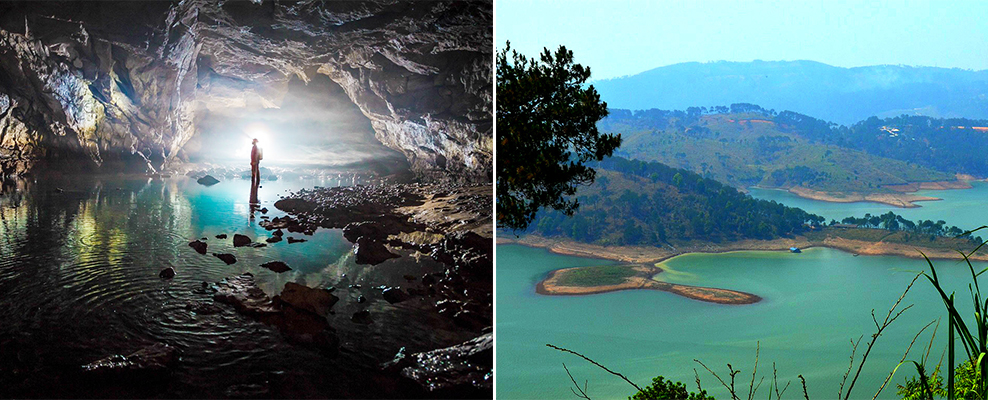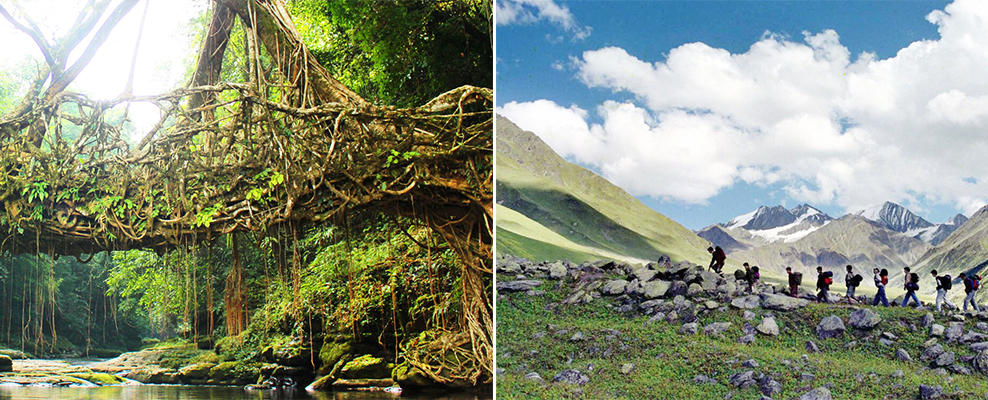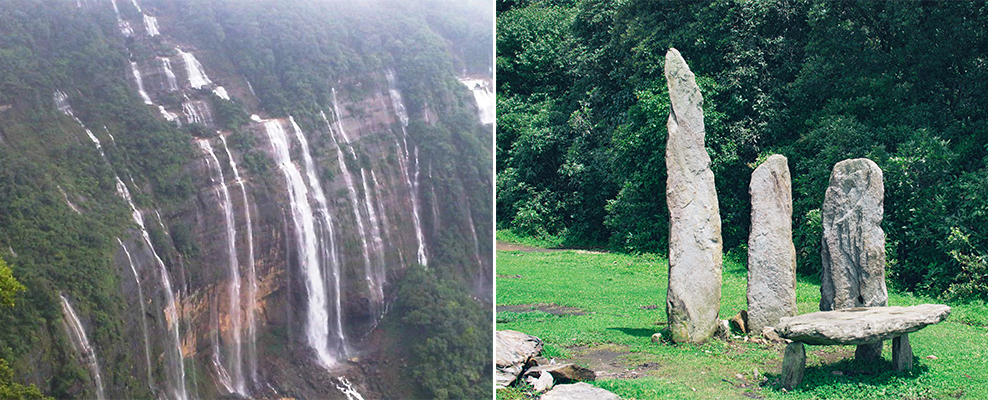As I prepare to capture my perspective of beautiful Meghalaya, I find myself floundering to find the words, though the myriad experiences of my trips to this picturesque part of the country are at my fingertips. Quintessential, bold, somber, captivating, serene, yet robust, are but a few adjectives I have managed to retrieve from the recesses of my mind. Nevertheless, you get a fair idea of what I’m trying to convey, that stripped to its essence − its natural beauty, by its sheer power to assuage your senses, would leave you spellbound! No wonder, it’s capital, Shillong has been coined ‘Abode of the Clouds’ or even ‘Scotland of the East’. Earlier in this series, I had written on Shillong, so I’m moving on to other, interesting places in Meghalaya.
Right from Shillong across scenic Dawki to Mawlynnong, voted the cleanest village in Asia and on towards Cherrapunji, the wettest place on earth, a trip to Meghalaya is extremely fascinating. The state records an average of 12,000 mm of rainfall in a year. In fact, Cherrapunji holds the world record for the most amount of rain in a calendar month, while that of nearby Mawsynram is the highest in a year. On a visit to Cherrapunji once, we stayed at this beautiful Polo Orchid Resort and enjoyed ourselves thoroughly. During the hot, summer months, tourists throng in Cherrapunji.

For those interested in mountaineering, rock climbing, trekking, hiking and water sports, Meghalaya holds immense attraction. The Umium Lake in Barapani has a water sports complex with facilities such as rowboats, paddleboats, sailing boats, cruise-boats, water-scooters and speedboats. Ranikor, about 140 kms from Shillong, is another popular destination for those who are fond of angling. It has a profusion of carp and other fresh water fish.
Interestingly, Meghalaya is dotted with an estimated 500 natural limestone and sandstone caves. It is proud of the Krem Liat Prah, the longest cave and Synrang Pamiang, the deepest cave in the sub-continent. These are located in the Jayantia hills. People from all over the world visit Meghalaya to explore these fascinating caves.

Another interesting feature of this state is its living root bridges. These are unique and natural bridges spread across Cherrapunji and Nongtallang. They are created by a calculated concept of training the arial roots of Ficus elastic trees planted on opposite banks of the river or hill slopes. This summer I had visited the one in Mawlynnong village on our way to Dawki. Quite a steep climb over rocky steps, it was worthwhile because of the beauty of its meandering path ending in a natural waterfall and rocks forming a pool.
Dawki is popular with tourists. In fact, the fad is to hire bikes and embark on a fascinating drive past undulating, hilly, terrain, rain drenched skies and wisps of clouds tenderly blanketing the tips of the hills. Be sure to carry raincoats and waterproof backpacks since sudden showers are inevitable in this part of the country. Ramshackle cottages, vintage structures, quaint eateries dot this charming place, a dream for nature lovers and those looking for adventure.
Dawki is approximately 96 kms from Shillong. An interesting fact is that one can catch a glimpse of the neighboring country, Bangladesh. The annual boat race every spring, a colorful event, is graced by a lot of tourists.

Those interested in folklore simply must check out the Kshaid Dain Thlen Falls located near Cherrapunji. Shrouded in fascinating legends, it is believed that the mythical monster, Thlen, was butchered right on the rocks underneath the cascading water. In fact, the axe-marks reflecting the evidence of the slain beast are pointed out by the tour guide. This adds to the eerie atmosphere. Here, I have to share a ghoulish part of our sightseeing tour, visiting Dwarksuid or the “Devil’s Doorway”. This is a splendid, natural pool, surrounded by wide, rocky, sand banks. The somber, brooding, rustic surroundings are a perfect foil for the sinister name. Situated right besides the Umroi Bhoilimbong Road, Dwarksuid is a must visit. The name has an interesting connotation. In the Khasi language, ‘Dwar’ means ‘Door or Entrance’ and ‘Ksuid’ refers to the ‘Devil’ or rather ‘Dark Spirits’. Cocooned amidst the swirling waters banked by the dark rocks, it emanates a pall of gloom.
I must also not fail to mention the extremely interesting Sacred Forest Mawphlong, which has a hallowed history. It is about 25 kms away from Shillong and is the most celebrated grove in Meghalaya. Preserved since ancient, prehistoric times, it boasts of a wide spectrum of vibrant flora, a thick blanket of humus on the grounds accumulated over the centuries and trees laden with a dense profusion of aroids, pipers, ferns, fern-allies and orchids. A visit to the Sacred Forest is a part of most tours. A local guide took us right inside. Entry otherwise is not permitted. Different packages are available for a guided tour of the three segments which comprises the Sacred Forest of Mawphlong.
A dream for nature lovers, as one steps inside the forest, one is transported to a different world altogether. We gaped in wonder at the dense foliage replete with trees which have been in existence for thousands of years. I thought the forest has been preserved incredibly well. Our excellent guide of course made it all the more educative and memorable. Also the price was extremely reasonable for such a tour.
One thing to be kept in mind is that nothing can be taken from the Sacred Forest, not even a fallen leaf. Local people staunchly believe that one would be cursed otherwise and never be able to get out safely. As for relieving oneself here, it is an absolute taboo!
Those interested in treks must surely check out the David Scott trail behind the Sacred Forest. The guide would be charging extra for it. One can get in touch with Om Travels, Guwahati, for a fascinating tour of scenic Meghalaya. A good, local guide makes it all the more interesting, instead of one merely indulging in rehearsed, monotonic, rhetoric!
